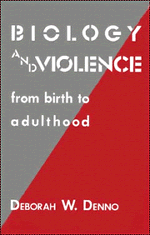Book contents
- Frontmatter
- Contents
- Foreword by Marvin E. Wolfgang
- Preface
- Introduction
- 1 Biological and environmental influences on crime
- 2 Violent criminals as children and as adults
- 3 Intelligence and crime
- 4 Biological and environmental predictors of crime
- 5 Case studies of violent and career criminals
- 6 Biology and responsibility
- Appendix: Selection and distribution of Biosocial Project variables
- References
- Author index
- Subject index
Foreword by Marvin E. Wolfgang
Published online by Cambridge University Press: 04 August 2010
- Frontmatter
- Contents
- Foreword by Marvin E. Wolfgang
- Preface
- Introduction
- 1 Biological and environmental influences on crime
- 2 Violent criminals as children and as adults
- 3 Intelligence and crime
- 4 Biological and environmental predictors of crime
- 5 Case studies of violent and career criminals
- 6 Biology and responsibility
- Appendix: Selection and distribution of Biosocial Project variables
- References
- Author index
- Subject index
Summary
The Collaborative Perinatal Project (CPP), launched in 1959, was one of the most ambitious and costly medical projects undertaken until then. Designed to obtain base-line data on birth defects, the project has yielded hundreds of ancillary books and articles in the medical literature. This remarkable study covered twelve cities, including Philadelphia, and when the data collection process ended the original records were put into storage. Upon learning of the project, and having engaged in an earlier birth cohort study, I sought permission to access the files and had significant physiological, psychological, and psychiatric data converted to computer tape for future use.
When the National Institute of Justice learned of our data bank, we were encouraged to submit a proposal that would link the CPP data with school records and files from the Juvenile Aid Division of the Philadelphia Police Department in order to determine how many of the children born each year of the project had a record of delinquency. Our previous experience with a 1945 birth cohort informed us about how to analyze delinquency through the span of years from age 10 to age 18. Because most of the staff of the Sellin Center for Studies in Criminology was involved in yet another birth cohort – those born in 1958 – it was necessary for me, as director of the Center, to select someone capable of learning the medical literature in order to make the proper analytical linkages with the known sociological variables and forms of delinquent behaviors. That someone, I knew from the beginning, was Deborah Denno.
- Type
- Chapter
- Information
- Biology and ViolenceFrom Birth to Adulthood, pp. ix - xPublisher: Cambridge University PressPrint publication year: 1990



